1. Barn Swallows Are World Travelers

Barn swallows are found all over the world. You can spot a barn swallow on six continents: North and South America, Europe, Africa, Asia and Australia. They’re most common over fields, farmland and water. They are a long-distance migrant that can be seen at many spring migration hotspots across America.
See expert tips to identify more types of swallows.
2. Barn Swallows and Early Conservation
George Grinnell played a huge role in early conservation. After he became editor of Forest and Stream magazine in 1876, he launched a campaign to stop barn swallows and egrets from being hunted for hat feathers.
Learn how to identify and attract a purple martin.
3. Barn Swallow Meaning and Symbolism

Traditionally, British sailors would get a barn swallow tattoo after traveling 5,000 nautical miles. The bird symbolized the hope of the sailor returning home or to a loved one. There are other birds that carry deep symbolism. Here’s what it means if you see a cardinal.
4. Barn Swallow Nests

Male and female pairs build an open cup-shaped nest together, working into the base, dried grass and white feathers to provide a soft lining. Feathers are popular nest-lining items for several kinds of swallows. Barn swallows commonly nest in the eaves of houses. During the breeding season, keep an eye out for puddles on your property. You may see these birds collecting bits of mud for their nests. If you’re lucky, they may come back to the same nesting spots each year.
Learn more about swallow nests and nesting habits.
5. Barn Swallow Eggs

Each nest holds four to five bird eggs on average. Eggs are very pale, elongated ovals with reddish brown spots. Breeding pairs have one or two broods a year.
Cliff swallow vs barn swallow: find out how to spot the differences.
6. What Do Barn Swallows Eat?
Some experts suggest that one barn swallow can gobble up to 850 bugs a day. They’re on the hunt for larger insects like flies, beetles and wasps. Tree swallows have a more varied diet.
7. Barn Swallow Flight
These birds are commonly seen swooping low over fields or water, eating their food on the go. But they’re also known to look for prey up to 100 feet in the air.
Discover 7 fascinating facts about swift birds.
8. Will Barn Swallows Nest in a Bird House?

Barn swallows will gladly take up residence on a nest shelf or a nest box. Visit the NestWatch website to learn about nest shelves and where to place them.
These birds prefer the eaves of roofs and under structures like bridges. Before permeant man-made structures were common in North America, barn swallows primarily nested in caves.
Barn swallows sometimes raise a different brood in the same nest. Learn which other birds reuse their nests.
9. How to Attract Barn Swallows
Barn swallows skip most feeders, including suet feeders. They like areas with clear airspace and plenty of bugs. But if you put out crushed eggshells, they may take a nibble. This helps them with digestion and gives them a boost of calcium.
Next, learn how to make a purple martin gourd house.
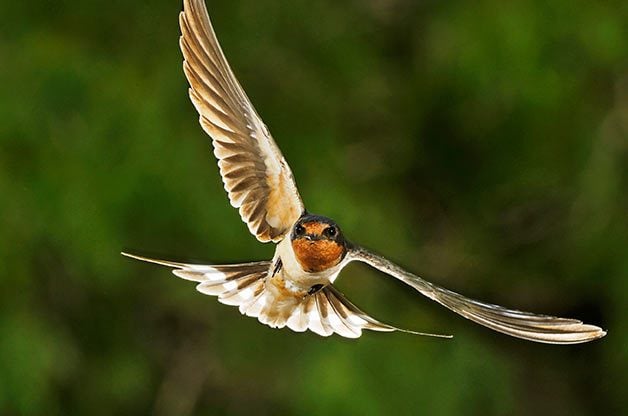
Swallows are different from any other songbird. Their habitat isn’t tied to the woods, meadows or our backyards. Instead, their true home is the sky. These graceful fliers are constantly on the go, ranging widely to feed on swarms of flying insects. They can live practically anywhere as long as they can find places to build their nests. In fact, those nests determine much about their lives. So let’s take a look at swallows nest habits and how these birds raise their young.
Learn to identify 8 types of swallows.
Swallows That Nest in Trees

Natural holes in dead tree trunks—whether drilled by woodpeckers or left by decay—provide nesting sites for many kinds of birds. Among them are two swallows with snowy white bellies and iridescent backs: the tree swallow, found from coast to coast, and the violet-green swallow, widespread in the West in summer.
Find out more about burrowing and ground nesting birds.
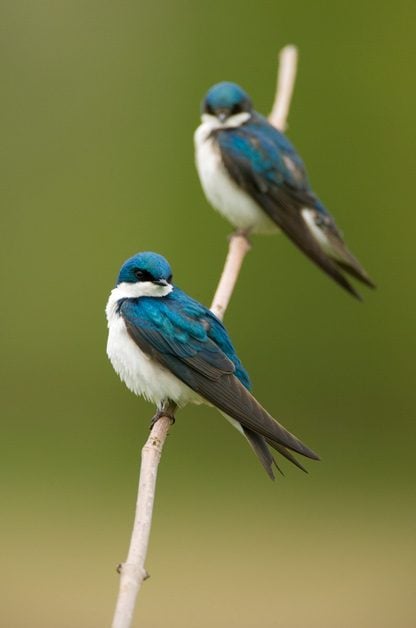
Like other cavity-nesting birds, these swallows will also accept nest boxes if you put them up. The tree swallow has benefited from the popularity of bluebirds, because it can use the same size and style of nest box as bluebirds do. Every year, vast numbers of baby tree swallows hatch out of boxes along “bluebird trails”!
Here’s how to make a DIY bluebird house.
Apartment Dwellers: Purple Martin Nests

The largest North American swallows, purple martins, once nested mainly in tree holes. They are sociable birds, so they would have to find several holes close together for families to nest in loose colonies.
Today, almost all the purple martins east of the Rockies (and some of those farther west) have adopted nesting boxes put up by their human admirers. These consist of apartment-style houses, often with dozens of rooms. In the far West, however, you’ll find places where martins still nest in tree holes in the traditional way. And in deserts of the Southwest, some purple martins nest in holes in giant cactus forests, finding places where several tall cacti close together have multiple woodpecker holes.
Baby swallows are too cute — here are 16 super sweet photos of them.

If you want to attract these popular birds, putting up purple martin houses is your best bet. Of course, it doesn’t hurt if you’re near open fields where they like to search and swoop for their meals.
Here’s how to make a purple martin gourd birdhouse.
Swallow That Nest in the Dirt

It might seem odd that creatures of the sky would raise their young in nests underground, but that’s exactly the type of nest site that bank swallows and northern rough-winged swallows build. Specifically, their nests are holes tunneled into vertical dirt banks. Both species sport soft brown hues to serve as camouflage when they land at the entrances to their nests.

Rough-winged swallows establish their nest sites as isolated pairs, but bank swallows choose to live in colonies. In some places, high dirt banks are riddled with holes, with dozens of pairs of bank swallows nesting close together.
Learn about different kinds of bird nests and how to spot them.
Barn Swallow Nests and Cliff Swallow Nests

The barn swallow is named for one of its common nesting sites, but it needed shelter long before people built barns. So it would find a shallow cave or a cliff with enough of an overhang to protect its nest. Its cousin, the cliff swallow, would use the same locations, usually nesting in colonies.
After settlers began building barns across the landscape, barn swallows moved in, building their nests on rafters inside. Cliff swallows adopted the outsides of the barns, plastering their muddy nests along the walls under the edges of the roof.

The cave swallow is a special case. This was once a rare bird in the U.S., building its nest in the shadows inside a few caves near the Mexican border. You can still find it in those caves, but now it has also discovered artificial substitutes that are much more widely available. Today there are cave swallow nests under bridges and in culverts all over Texas and in parts of adjacent states.
What is a fledgling? Learn the five stages of a baby bird’s life.
Swallow Nest Boxes and Structures

Many of our swallows are undoubtedly more common today than they once were. The cave swallow is just one example. Barn swallows and cliff swallows also build their nests under bridges, as well as in and on barns and other structures, so now they thrive in areas where they would have had no natural place to nest.
Tree swallows, violet-green swallows and purple martins all readily take to birdhouses. Even bank swallows and northern rough-winged swallows take advantage of new artificial dirt banks, such as at road cuts and gravel pits.
Follow these proven tips to attract nesting birds.
Swallow Bird Migration

Although their nesting habits differ, members of the swallow family lead similar lives in most other ways. All of them feed on flying insects. Some other songbirds do, too, of course, but those others usually fly out from a perch to catch a single insect and then land again. Swallows may stay on the wing for hours in seemingly effortless flight, traveling far and wide to find swarms of small insects.
When insects disappear in cold weather, swallows migrate to warmer climates. Some, like cliff swallows and purple martins, fly all the way to South America’s Amazon basin. Tree swallows may stay through the season in the southern U.S., because they can survive on berries when cold weather shuts down insect activity.
Before they go south, most swallows gather in large flocks, spending days or weeks foraging and fattening up for their travels. Often they gather near water or over open fields. Flocks may contain hundreds of swallows, or even thousands, including four or five different species. Late summer is the best time to see these gatherings. Watch for swallow flocks circling over ponds or perched on roadside wires, and you may get to admire an abundance of graceful, beautiful world travelers.
Learn 7 fascinating facts about swift birds.
Types of Swallow Nests

- Barn swallow: An open cup made of pellets of dried mud mixed with grass and lined with feathers.
- Cliff swallow: Plastered against a vertical surface, the nest is a gourd-shaped vessel made of dried mud pellets, with the entrance at one end. The inside has a sparse lining of grass and feathers.
- Northern rough-winged swallow: Situated at the end of a horizontal tunnel in the dirt, the nest is a bulky mass of twigs and weeds, lined with finer grasses.
- Tree swallow: A neat cup of grasses, weeds, pine needles, moss and other plant material, almost always with a soft lining of feathers.
- Purple martin: Inside an apartment in a martin house, the nest is a cup of grass, leaves, twigs, miscellaneous debris and usually some mud.
Psst—this is the only bird nesting material you should put out.
On This Page
Reasons to Make a Purple Martin Gourd House
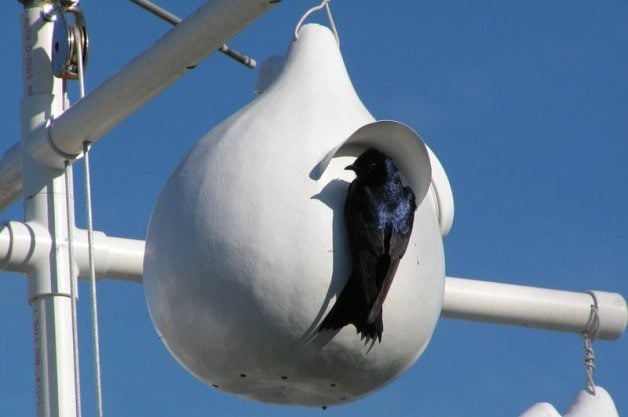
Gourds have been used to make purple martin houses for centuries. Native Americans used to hang them to attract martins to their settlements to help control insects. Today, purple martins east of the Rocky Mountains depend on people to supply them with houses and gourds. Time spent creating a purple martin gourd house is a worthwhile investment. Cured hard-shell gourds are almost as tough as plywood, and they will last up to 30 years if properly coated with a preservative and handled with a little care.
Do purple martins eat mosquitoes? Here’s what you should know.
These basic gourd birdhouses are popular with the birds and purple martin landlords. The best part is, there’s no limit to the number of homemade purple martin gourd houses you can produce and hang right in your yard. We’ve heard of one purple martin enthusiast who puts up and maintains more than 600 gourd houses every year!
Check out more unique birdhouses birds will actually use.
Prepping the Gourd

To start, you’ll need one hard-shell gourd, also known as a bottle gourd or birdhouse gourd. Harvest a hard-shell gourd when the vine has withered. Be careful to leave the stem attached. It’s best to cut the stem with pruning shears so you don’t bruise it. A good purple martin gourd has a diameter of about 8 to 13 inches. Wash it thoroughly in water, rinse in a solution of 1 part disinfectant (bleach works fine) and 10 parts water, and dry it with a towel.
Hang the gourd in a sunny spot or place it on newspaper in a warm dry spot (such as an attic or basement) for 3 to 6 months. If the gourd is lying on a flat surface, be sure to frequently turn it. The gourd will begin to mold as it dries—don’t throw it out! This is a natural part of the curing process. Gourds dried indoors will grow the most mold and should be wiped clean frequently with the same concentration (1 to 10) of disinfectant you used for cleaning. However, discard any gourds that become soft or wrinkled.
Check if the gourd is dry by giving it a good shake—if the seeds rattle, it’s time to make a purple martin gourd house!
Learn how to grow pumpkins and gourds.
Materials for a Purple Martin Gourd House:
- One hard-shell gourd, also known as a bottle gourd or birdhouse gourd
- Bleach (for disinfectant)
- Fine steel wool
- Wood preservative or copper sulfate
- Oil-based primer
- Oil-based white enamel paint
- Plastic-coated copper wire, 24 inches long
- Face mask
- Power drill
- 2-1/8-inch hole saw or a keyhole saw
Step-By-Step Instructions:
Step 1
Soak the gourd for 15 minutes in hot soapy water, then scrape it with a dull knife to remove the outer skin and mold. Scrub the gourd in the water with fine steel wool. Rinse it well and allow it to thoroughly dry.
Step 2
To locate the entrance hole, hold the gourd by its stem between your index finger and thumb and let it hang. Mark a center point along the outermost part of the curve so the hole faces straight out—not towards the sky or the ground. The hole should measure 2-1/8 inches and can be easily and quickly drilled with the proper-size hole saw. (Be sure to wear a face mask.) You can also use a keyhole saw to cut the entrance by hand. If you do, it’s best to cut the hole immediately after washing the gourd, while it’s still wet.

Step 3
Make seven drainage holes in the bottom of the gourd about 2 inches apart using a 5/16-inch drill bit. With the same bit, drill two sets of holes about 2 inches from the top of the gourd’s neck for hanging and ventilation. One set should be drilled perpendicular to the entrance hole and the other in line with it. (You’ll only use one set of holes for hanging. Choose the pair that will allow the entrance hole to face the most open direction.)
Step 4
Remove seeds and membrane through the entrance hole with a long-handled metal spoon, screwdriver or a wire coat hanger (wear a face mask). If this is difficult, soak the gourd in water for several hours. The inside does not have to be completely clean.
Step 5
Dip the gourd in a wood preservative for 15 minutes, weighting it down with a brick. Then remove the gourd and hang it up to dry for several days. (For a cheaper alternative, dissolve 1 pound of copper sulfate (available at garden centers and farm-supply stores) in 5 gallons of warm water and dip the gourd as instructed above. Wear rubber gloves while handling it.)
Tip: Gourds need to be retreated and repainted every few years. So whatever preservative you use, store the solution in a covered plastic bucket for reuse, but keep it away from children and pets.
Step 6
Sand the gourd smooth and paint with an oil-based primer. Allow it to dry. Paint the gourd house with white exterior enamel paint with a nylon brush. (Do not use water-based latex paint because it will peel.) Apply two coats. Be careful not to clog drainage holes.

Step 7
When dry, you can hang your gourd (you’ll need at least 4 to 6 gourds to attract purple martins) from a 24-inch plastic-coated copper wire. Thread the wire through two of the holes directly across from each other and hang it from a support line, below a martin house or on a specially made gourd rack. Hang the gourd 10 to 15 feet high, with the entrance hole facing an open area. The gourd will swing, making it less attractive to nest competitors, such as starlings.
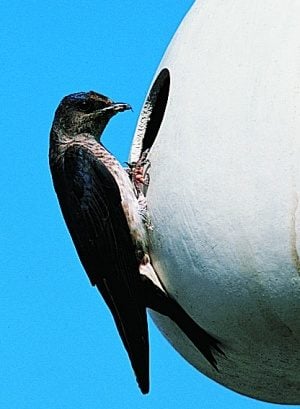
Purple Martin Gourd House Maintenance
In late August or early September, after the martins depart for their winter homes in the tropics, take the gourd house down for cleaning. Break up nests with the handle of a wooden spoon and shake out the contents. Then store until early spring (the martins return as early as February in the deep South) in a spot inaccessible to rodents. Your gourd house will be ready to use again, but you might want to prepare a few more over winter, because the martins will probably bring along a few more friends!
Learn all about swallows nests and nesting habits.
Gourd Birdhouses for Other Birds

If you live in an area that’s not the most suitable for attracting purple martins, don’t despair. Gourds make fine homes for several varieties of cavity nesters. Some birds you could attract include bluebirds, swallows, chickadees, wrens, woodpeckers, great crested flycatchers, titmice, screech owls, kestrels and nuthatches.
Each bird species has its own requirements for habitat, entrance-hole size and cavity dimensions. For instance, house wrens need a 1-inch entrance hole in a gourd 5 to 6 inches in diameter and prefer gourds hung in a shady area close to brush.
Chickadees need a 1-1/4-inch hole and like to nest in wooded areas. Bluebirds and tree swallows require a 1-1/2-inch hole and prefer to nest in open areas. For flycatchers, make the hole 1-3/4 to 2 inches in diameter and hang the gourd in a tree close to a brushy area.
Next, meet 8 types of swallow birds you should know.
When is Black Birders Week in 2024?

The fifth annual #BlackBirdersWeek takes place from Sunday, May 26, to Saturday, June 1, 2024. This year’s theme is “Wings of Justice: Soaring for Change.”
Black Birders Week aims to spotlight the many unique ways Black people connect in the outdoors. The event is coordinated by The BlackAFInSTEM Collective – a collective that “seeks to support, uplift, and amplify Black Science, Technology, Engineering, and Mathematics professionals in natural resources and the environment through professional development, career connection, and community engagement.”

Walking in the woods, spotting a bird through your binoculars is an activity everyone should be able to enjoy. Unfortunately, people of color sometimes feel unwelcome while pursuing their passion for nature. Black Birders Week continues the goals of lifting up black birders, forming a community and fighting discrimination. The event began in 2020 as a response to renowned birder Christian Cooper being racially profiled and harassed in New York’s Central Park.
Get bird-watching tips for beginners.
How to Participate in Black Birders Week 2024

Visit the BlackAFinSTEM website for a schedule of daily events, including bird walks, networking events and more.
For more ways to participate in Black Birders Week, follow the hashtag #BlackBirdersWeek and connect with @BlackAFinStem on Instagram, Facebook and Twitter. Share photos, engage with the content and videos, and support acceptance for all bird lovers.
Ashley Gary, founder of TheWildlifeHost.com, says, “I’m so excited to be a part of this movement to turn this injustice into a spotlight for the black people who endure bias and harm as we just try to enjoy the natural world around us.”
Go birding in the city! Here’s how to be an urban birder.
Raise Awareness

Naturalist and environmental educator Marcus Rosten is the Aquatic Invasive Species Program Manager for Western New York Partnership for Regional Invasive Species Management. He says, “Black Birders Week is important to me because it is great to raise the awareness that black birders exist. Growing up I did not know any environmentalists or outdoors people that looked like me,” he says. “This week is a reminder to non-black birders that we are out here sharing the same spaces. Unfortunately I have had occasions where I have been perceived a threat and have been threatened for just birding in the local hotspot that I explore weekly.”
Let’s go birding with the Wisco Birder.
Diversity of Voices
Chelsea Connor is a university student in Texas from the Commonwealth of Dominica. She has had a long standing love for birds, constantly poring through her cherished field guide copy for her island. Chelsea fondly recalls observing her grandmother’s small flock of bananaquits feed on sugar when she visited, and watching a mated pair of Sisserou (endemic parrots) at her island’s Botanical Gardens.
“Black Birders Week was created to promote visibility and increase the representation of Black people in the field. We are being seen and people are talking about it. Those dialogues are important in order to have more Black people enter, stay in and flourish in birding. It’s not enough to just say you’re bringing in people because diversity is needed, you have to make sure they’re still on equal footing once you get them in there,” Chelsea says. “Black Birders Week is amazing and the response is breathtaking. It’s showing me that there is a place for me in my field, for my voice, experiences and insight.”
Ready to go birding? Check out the best coast to coast birding hotspots for every season.

Caring for roses was once an art form, including fastidious pruning, spraying for diseases and pests, and wrapping in winter. While some gardeners are still committed to the craft, Knock Out roses are a better option for low-maintenance gardeners. Their development marked a shift in what roses can be. Tough as the thorns adorning their stems, Knock Outs boast luscious, well-rounded foliage and flowers that just can’t quit. To fully understand how Knock Outs were produced, it’s helpful to know a few things about William Radler, their creator.
Learn how to choose the best roses for your garden. Don’t miss out on learning how to prepare and prune roses for winter, either.
An Idea Arose for a Better Rose

As a child, William—who prefers to be called Will—spent time with his siblings at his grandparents’ house, where they had to make their own fun. The home was relatively devoid of entertainment for children, with the exception of a few National Geographic magazines and a rose catalog. He would flip through the catalog’s pages, drawn to the elegant cultivars, naming them as he went.

Decades later, he served as director of Boerner Botanical Gardens in Hales Corners, Wisconsin, while carefully and deliberately crossbreeding large plots of roses in his own yard. Will dreamed of an even more vigorous rose, one that didn’t need pesticides or constant attention. “Everything I learned about roses told me that producing a rose like the Knock Out was possible. Probable? No. Possible? Perhaps.”
Discover 18 fragrant roses to perfume your garden.
Nosy Neighbor Gives Approval

Through the 1980s, Will bred prolific bloomers—shrubs with perfect growth habits and crosses that could take just about everything but the kitchen sink. Eventually, he discovered a plant that hit every single mark. “It had this well-rounded shape with perfect foliage that didn’t get diseased,” Will says. “When it started blooming, it just kept blooming and blooming. Even in the fall, when the rest of the roses started looking tired, Knock Out didn’t.”

The testament to this discovery came when a particularly persnickety neighbor walked up to his front porch. According to Will, this was a common occurrence—she always had a piece of unsolicited advice or less-than-constructive criticism. He opened the door, and she pointed her finger at a particular rose bush and said, “You know, if you could produce more roses like that—you would really have something.”

Shocked by the positive comment, Will realized he had created something special. The next concern was whether the average gardener—the person he felt would benefit most from the Knock Out—would like it.
Learn 8 surprising facts about roses.
Knocking Out the Rose World

“I didn’t even know if I’d be able to get it into the market for sales,” Will says. He added that when it was released in 2000, rose breeders were working on scarlet red roses, while the original Knock Out was red but as close to purple as possible. But it sold. Sales improved yearly, defying the crash most roses see after being on shelves for a few springs. It certainly deserved the hype.
Knock Out Rose Care

Knock Out roses routinely grace best-of and top 10 lists because they bloom from June to frost, are especially resistant to black spot, do better than others in part shade, and withstand winter in most regions without bulky insulation. Will’s Knock Outs come in many varieties with both single and double petals, and range from cherry red and vibrant pink to creamy yellow and pure white.
Knock Out roses are well suited for growing zones 4 to 11, and perform best when planted in full sun and well draining soil.
Roses love garlic: Here’s why
Rosy Future Outlook

Will hasn’t slowed down—he still breeds and tests roses at his home. He’s working on the usual suspects: bright new colors, more disease and pest resistance, and increasing the scent of the blooms—that’s something critics say is more subdued in Knock Outs than in traditional roses.

But Will has something bigger up his sleeve. “I would really like to produce the first rose with full-season interest,” he says. He’d like to see a specimen with colorful, thornless canes in autumn and bright fruit that lasts through winter for birds or dried bouquets. When asked what rose traditionalists may think of a thornless rose, he answered quickly: “I don’t care.” His roses are for everyone, he says, not just gardeners with a static idea of what roses can be. “I may be taken as a dreamer,” Will admits.

But he believes that if you don’t have big dreams, you’re not going to see the rewards. His dream may not be that far away. I talked to Will on a cold November day, just after the first snow of the season. He led me outside to his test gardens and pointed to a frosty thornless rose bush. Will says, “While Knock Out made a major breakthrough in what people want, it isn’t the end of the line.”
Rose color meanings: What you should know.
Rose Boot Camp

Life isn’t a bed of roses for the plants grown in Will Radler’s test gardens. After seedlings go through an intense review in his basement workshop, a lucky few get planted in the test garden, affectionately called the boot camp. Young bushes are planted close to each other to encourage disease, and they’re generally mishandled. They’re watered from overhead around dusk (typically a no-no) and diseased leaves are saved, ground up and sprinkled on healthy plants routinely. The abuse is purposeful. Many roses meet their end in a trash pile, but the best plants receive more testing and may even make it to a grower.
This rugosa rose deserves lots of love.
Where to Buy Knock Out Roses

Knock Out roses are available at garden centers nationwide and are sold online at many retailers including The Home Depot and Nature Hills Nursery. One of the newest varieties to grow is the Petite Knock Out rose. This bushy, flowering plant grows to a maximum height of 18 inches, making it the perfect size to place in a container. The bright red blooms are long lasting and the plant is just as tough as its larger Knock Out rose cousins.
Birds That Nest in the Ground

Birds create an amazing variety of nests to shelter their eggs and young. Some construct massive platforms of sticks in tall trees, others weave intricate cups of plant stems hidden in shrubs or vines, and a few lay eggs inside holes in trees or on a smoothed-over pile of beach sand. But the best-protected and most unusual nests are those placed in subterranean burrows. Meet the ground nesting birds that have adopted this underground strategy.
Kingfishers

With hefty beaks, shaggy crests and rattling cries, belted kingfishers are commonly spotted around lakes and rivers across North America. Hardly anyone, though, sees the tucked-away nests where they lay their eggs. Each pair of kingfishers finds a vertical dirt bank, often a high riverbank, and they take turns boring a horizontal tunnel. Loosening the soil with their sharp beaks and shuffling dirt back with their feet, they may dig for a week or more. The finished nook is usually 3 to 6 feet long but is sometimes more than 14 feet. A large chamber sits at the end of the narrow round tunnel.
In this secure shelter, parents incubate five to eight eggs for about three weeks and feed the growing nestlings for another four weeks. At that point, the young kingfishers are ready to come out of the burrow and learn to fly. Although the belted is the only widespread kingfisher in the United States, two others live close to the Mexican border. The green kingfisher is a tiny bird, smaller than a robin but with an enormous beak, while the ringed kingfisher is a bruiser, larger than the belted. They all share the family habit of building nests in dirt banks.
Burrowing Owls

Named for their distinct below-ground habits, burrowing owls scuttle over open prairie and desert floors in the western states and Florida. They’re active by day, making them easier to watch than most owls. In the western states, the owls usually dwell in prairie dog colonies, where they take over abandoned quarters. In Florida, many burrowing owls live in vacant lots in towns, and some communities proudly adopt and protect local colonies. Unlike their western cousins, the Florida owls regularly excavate their own homes. A pair may dig a tunnel 10 feet long in only two days.
An old western nickname for the burrowing owl is “howdy owl,” because it appears to nod its head as a way of saying hello. Cowboys had many legends about these birds, including that the owls, prairie dogs and rattlesnakes would live together peacefully in the same burrow. They don’t, of course. But here are the facts behind the myth: When they’re disturbed, the young owls make a harsh buzz that sounds very much like the rattle of a snake. Hearing that sound from deep in a burrow may be enough to make humans (and other animals) stay away.
Learn how to attract owls to nest in your backyard.
Swallows

Many swallow nests are out in the open. Barn swallows, of course, build nests in barns, on porches and in sheds, using stiff, dried mud as a foundation. A couple of types of swallows interact with mud and dirt in other ways. Bank swallows and northern rough-winged swallows are common from coast to coast in summer. Both nest in holes. Bank swallows create tunnels in steep dirt riverbanks, where they seem to love company. On high banks, the lairs of dozens of birds—sometimes a thousand pairs or more—may crowd together, entrances only inches apart.

Horizontal tunnels average about 2 feet long. Some bank swallows dig up to 5 feet into the soil—that’s quite a feat considering these are the smallest swallows, with bodies less than 5 inches long. Northern rough-winged swallows are not nearly as sociable, living in very small groups or as isolated pairs. Unlike their hardworking cousins, these ground nesting birds usually don’t make their own burrows. Instead, they find holes abandoned by rodents, kingfishers or other creatures, or move into vacant digs at the edge of a bank swallow colony.
Seabirds

The most mysterious burrowers are found among the true seabirds. Many of these ocean dwellers raise their young on islands. The smaller species often excavate burrows or find hollows buried deep among the rocks. Hidden away, the homes are safe from large gulls and other predators. This secretive behavior seems fitting for storm-petrels, little dark seabirds that flutter low over the waves. They come and go from their nests only at night. Islands off both the Atlantic and Pacific coasts have thousands of these ground nesting birds.
On the Farallon Islands near San Francisco during the day, for example, you’d never guess how many of these secretive birds are concealed underground. On the other hand, puffins, which are also ground burrowers, are famous even among people who have never seen one in the wild. With their upright posture and colorful beaks, puffins are pictured on signs and T-shirts in coastal communities in Maine and Alaska. They seem flashy, but when it’s time to choose a nest site, they go below ground—digging or finding a deep crevice among the rocks. It’s just one more example of the ways birds can be endlessly surprising.
Next, learn how long baby birds stay in the nest and more nest facts.
On This Page
Meet the Swallow Bird Family

An old saying goes, “One swallow doesn’t make a summer.” Fortunately, we don’t have to settle for just one species. During the summer, members of the swallow bird family are common all over North America—from the tropical borders to the chilly Arctic. Swallows are incredibly graceful songbirds, able to swoop and glide for hours as they chase small insects in midair. Most are very sociable, often gathering in flocks on roadside wires whenever they’re not flying. Beloved by bird-watchers, the birds are often found close to people, nesting around houses and farms.
Learn about swallows nests and nesting habits.
Barn Swallow

Historically, orange and blue colored barn swallows placed their nests inside shallow caves or on cliff faces protected by overhanging rocks. They looked for spots sheltered from the rain because their nests are made mostly out of mud pellets, plastered in place and allowed to dry.
When European settlers began building barns, these swallow birds quickly learned to use these shelters to their advantage. Today, almost all barn swallow bird nests are placed on man-made structures: inside barns or sheds and under the eaves of houses, bridges or docks. Such safe sites are much more abundant than naturally protected sites ever were, so barn swallows are undoubtedly more common today than they were several hundred years ago.
Discover 8 different kinds of bird nests and how to spot them.
Cliff Swallow

The cliff swallow, true to its name, used to nest mainly on the sheltered sections of cliffs, with many jug-shaped mud nests plastered close together. Although some colonies still persist in natural sites, most cliff swallows now nest on the outsides of buildings or underneath bridges. These birds are found from Alaska to Mexico and from coast to coast, but they’re generally more common in the West.
Cave Swallow

A related bird, the cave swallow, has a more limited range. As recently as 45 years ago, cave swallows were quite rare in the United States, nesting in a few caves in Texas and at Carlsbad Caverns National Park in New Mexico. Sometime around 1980, these birds discovered that they could also build their nests inside highway culverts, which resembled little caves. They also began nesting under bridges and other structures. Now they’re common summer birds across most of Texas, spilling over into Louisiana, Oklahoma and New Mexico.
Learn 7 fascinating facts about swift birds.
Tree Swallow

Steel blue on the top and snowy white below, the tree swallow was named for its habit of building its nest inside the holes of trees. These types of natural cavities are becoming harder to find in many areas as dead trees and limbs are removed from yards and parks. But the tree swallow benefits from a happy coincidence—it uses exactly the same size of nest hole that bluebirds prefer.
Is that a swallow in my bluebird box?
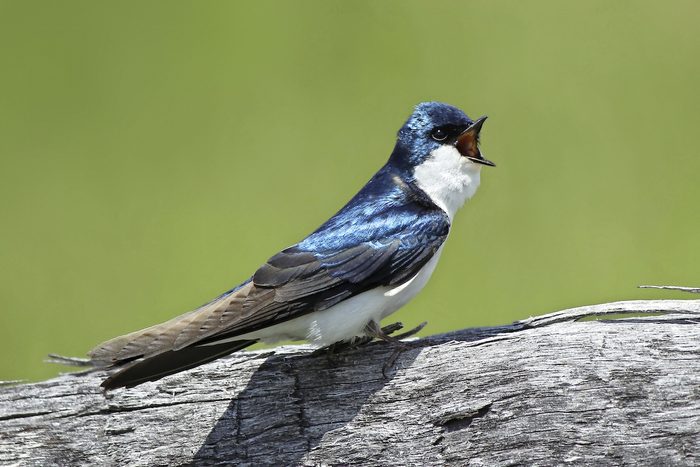
Devoted bluebird fans have put out vast numbers of nest boxes all across the continent. Learn how to choose the best location for a bluebird house. The bluebirds can’t use all of them, so many of those boxes are occupied by tree swallows every year. And the swallows also have their own fans who put out boxes specifically for them in favored spots, often where open fields are close to ponds or rivers.
Violet-Green Swallow

The colorful violet-green swallow, another cavity nester, has a brighter mix of colors on the back and more white on the face. Unlike the tree swallow, which is found from coast to coast, the violet-green is a specialty of the Far West. Violet-green swallows often choose to nest in a hole made by a woodpecker. It also uses nest boxes that are designed for bluebirds.
Bank Swallow and Rough-Winged Swallow

Two more kinds of swallows nest in holes, but not holes in trees. Both the bank swallow and the northern rough-winged swallow are shades of brown. This color camouflages them against the dirt banks where they dig and place their nests.
Bank swallows are highly sociable, forming colonies where up to a thousand underground tunnels may be crammed close together. Sometimes they choose the edges of man-made quarries, in locations where no natural dirt banks are available. In late summer, after nesting season ends, flocks of hundreds of bank swallows gather near lakes or marshes.

Northern rough-winged swallows are more solitary year-round, often nesting as isolated pairs and never forming large flocks.
Purple Martin

These birds are the largest swallows in North America, and arguably the most popular. Everywhere east of the Rockies in the United States and in southern Canada, homeowners put up elaborate multi-roomed houses, hoping to attract a colony of nesting purple martins.
Early spring migrants, purple martins come back from their winter haunts in South America. The purplish black males usually arrive before the paler females, and both reward their human hosts with lively activity and rich musical calls throughout the spring and summer.
In the West, where they are much less numerous, many purple martins use traditional nest sites in tree holes. In the Southwest, they use holes in giant cactuses. But in the East, almost all martins nest in houses that people put up just for them. Want to make your own abode for these birds? Here’s how to make a DIY purple martin gourd house.
It’s no wonder that many people are fascinated by purple martins and other members of the swallow bird family. With their graceful flight and gregarious nature, swallows make lovely wild bird neighbors.
I’ve grown tomatoes for as long as I can remember. Growing up, I even had my own stand at the local farmers market, selling cucumbers, peppers and lots of tomatoes. For the most part, we grew traditional red tomatoes. Every once in a while, we’d throw in a yellow or plum-shaped variety, but we didn’t go off track too much. Now I see tomatoes in a whole new light. You can find hundreds of different varieties out there in almost every hue imaginable. To help you navigate the sea of tomatoes, we put together this list of the top 10 best tomatoes to grow. Of course you’ll have your own favorites, but the list is a good starting point for those who are a little overwhelmed by all the choices.
Check out top tomato growing tips for the ultimate crop. Plus, here’s how to prevent the tomato hornworm from damaging your harvest.

Super Sauce
You wouldn’t think a Roma tomato would pack such a punch, but the name really says it all. Burpee claims a single 2-pound tomato will fill an entire sauce jar. So if you like to can your own sauce, SuperSauce could be your new favorite. Just imagine what an entire plant in your tomato garden could yield in one season.
Follow these tips for saving tomato and veggie seeds from your harvest.

Vernissage
You can now find a brand-new series of Vernissage tomatoes, developed by a young Ukrainian plant breeder. The pink variety with pale yellow stripes is one of the most popular, but you can grow a green, black or yellow version as well. The plants are prolific producers, and the fruit is colorful and delicious. The tomatoes average a petite 2 ounces. Just pluck them off the vine and enjoy!
Don’t make these 12 mistakes with your tomato garden.
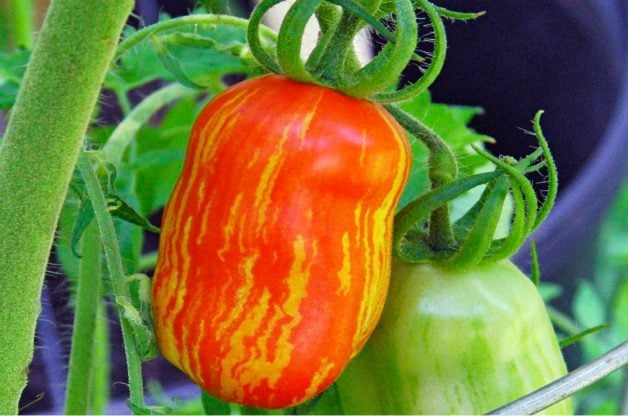
Casady’s Folly
Have a weakness for plum tomatoes? Check out breeder Tom Wagner’s creation. Outside, each gorgeous 4-inch fruit has attractive light red and orange stripes; the interior is deep red. When you bite in, you may notice a little bit of fruitiness. Casady’s Folly will please people who like their produce in fun colors and shapes.
Get the top 5 tips for growing tomatoes indoors (from a tomato expert).

Grafted Brandywine
It’s a fairly recent tomato trend: grafting so the plants will produce two or three times more fruit. You can find several grafted varieties, but we like the looks of the heirloom cultivar Brandywine, which has been a trusted product for decades. If you have a small space but want lots of fruit in your tomato garden, grafted tomatoes could be the solution. Ask about them at the garden center.
Discover 6 genius ways to use up extra tomatoes and veggies.

Fire Fly
We pay attention to the All-America Selections each year because it’s a good way to know which new flowers and veggies to watch for. These small fruits, sized between a currant and cherry, have attracted attention for their sweet flavor. Fire Fly is also said to be extremely resistant to disease, which will help extend the harvest season. This is another one of the best tomatoes to eat right off the vine or toss into a salad.
Stacy’s Tip: Following the All-America Selections each year is bound to give you inspiration for your own choices.

Celebrity
Chances are you’ve seen them at your garden center. Celebrity tomatoes were an All-America Selections veggie in 1984, and we think they still deserve top honors. They’re bright red, reliable and scrumptious—everything you love about tomatoes in summer. Since they’ve become a staple, they’re readily available, making them the perfect option for just about any backyard tomato garden.
Stacy’s Tip: Many Home Depot stores carry Celebrity tomatoes and you can also buy seeds online.

Sugary
Do you know someone who doesn’t like tomatoes? If so, this variety just might convert him or her. As the name suggests, Sugary is one of the sweetest and best tomatoes you can grow. Plus, it has a fun shape, pointed on both ends. A 2005 All-America Selections winner, it’s been popular ever since. It grows vigorously and will bear fruit all season, so you need only a plant or two for a good supply of fruit.

Green Zebra
What it lacks in size (only around 3 ounces), it makes up for in flavor—lots and lots of flavor. These small tomatoes fit in the palm of your hand and have lovely lime green stripes. The fruits turn yellow and soften a bit as they ripen, so you know when they’re ready to pick. Chefs love having these little tomatoes on hand.
Stacy’s Tip: Green Zebra is an heirloom. Learn the difference between heirloom and hybrid tomatoes.
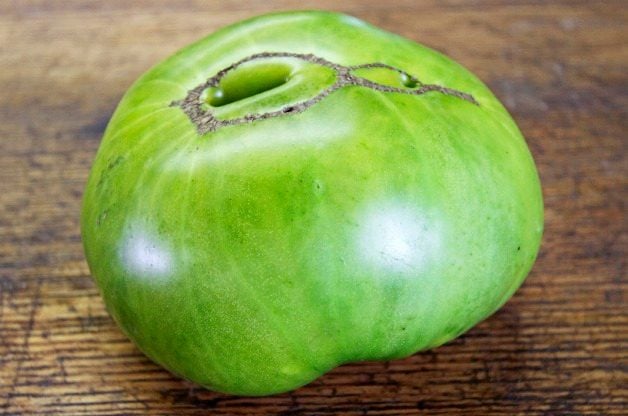
Aunt Ruby’s German Green
Yes, you can do more with green tomatoes than just fry them up. While most tomatoes start green and then redden as they ripen, these are ripe when they’re a vibrant lime green. Aunt Ruby’s German Green is one of the most talked-about heirlooms of recent years. It won the Heirloom Garden Show taste test back in 2003, and many gardeners say it has better flavor than most red tomatoes.

Black Cherry
These look a lot like the popular Super Sweet 100 cherry tomatoes, except the fruits turn from green to a deep cherry, almost black, as they ripen. And they taste great, too. Black Cherry, a hybrid tomato, produces dozens of fruits on a single vine, so don’t worry about sharing. You should have plenty to go around.
Add New Guinea Impatiens to Shade Gardens

Gardeners have long loved impatiens for their ability to provide colorful flowers in shade gardens. In the 1970s, New Guinea impatiens (Impatiens hawkeri) were introduced to U.S. gardeners, and while early varieties weren’t initially beloved, this plant has become a staple in many gardens now. They’re usually grown as annuals, planted in the spring in northern areas and year-round in frost-free zones.

Their colors include reds, pinks, oranges, and white. The foliage of New Guinea Impatiens is dark green and nearly purple on the undersides, making it attractive on its own. They blooms constantly and require little maintenance. Here’s what you need to know about growing New Guinea impatiens.
Check out the the best shade garden plants for your shady areas.
New Guinea Impatiens Care

- Sun or Shade? Like other impatiens, New Guineas don’t enjoy too much sun. They’re more sun-tolerant than other varieties, but they prefer bright light instead of direct sun. If anything, give them full sun in the morning (no more than 4 to 6 hours) and then shade in the afternoon. Any more and the leaves will burn and flowering will all but cease. You can also grow these flowers indoors.
- Water. New Guinea Impatiens need regular watering. They like moist soil, though not soggy roots. Ensure their soil, whether in the ground or in a pot, drains freely. These are plants that will wilt quickly when they don’t receive enough water, though they’ll usually recover if watered soon. Drip irrigation is a good way to keep these plants consistently moist without over-watering.
- Temperature. Daytime temperatures in the 70s and 80s F are ideal for these bloomers. Cooler nights are fine, but if temperatures drop below 45 F, they will start to suffer.
- Problems. In the past few years, impatiens downy mildew has caused problems in the United States, and New Guinea impatiens are susceptible to this disease, although some note they are more resistant. They may also be troubled by root rot, fungal disease, and aphids. However, most gardeners find these plants to be easy-care and trouble-free. Learn how to get rid of powdery mildew.
Next, check out the top 10 shrubs for shade gardens.